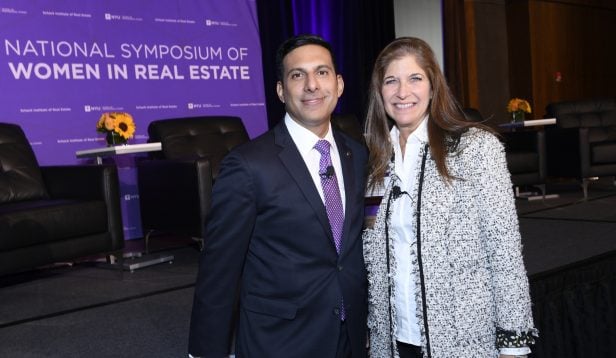 Sam Chandan, NYU USPS Shack Institute of Real Estate Larry & Klara Silverstein Chair in real estate development & investment, and Laurie Golub, chief operating officer and senior managing director at Square Mile Capital and conference chair _©Olivo: Courtesy of NYU Photo Bureau
Sam Chandan, NYU USPS Shack Institute of Real Estate Larry & Klara Silverstein Chair in real estate development & investment, and Laurie Golub, chief operating officer and senior managing director at Square Mile Capital and conference chair _©Olivo: Courtesy of NYU Photo Bureau
➤➤ Join the GlobeSt.APARTMENTS (formerly RealShare) conference October 29-30 in Los Angeles. The event will analyze the opportunity in the emerging trends and conditions of the multifamily market. Don't miss out on joining the 1000+ of the industry's top owners, investors, developers, brokers and financiers as they gather for THE MULTIFAMILY EVENT OF THE YEAR! Click here to register and view the agenda.
NEW YORK CITY-Asset managers are packing on community-oriented amenities to compete for and retain tenants in their multifamily properties. This phenomenon has become an amenities arms race as landlords throw a kitchen sink of offerings at prospective tenants. However, what is capturing the crowd is the desire for belonging, according to panelists at the NYU Schack Institute of Real Estate's Third National Symposium of Women in Real Estate.
"We have an amenity war occurring, that to attract tenants it's 'what can you do for me lately,'" said panel moderator Sherry Rexroad, managing director and senior product strategist at Blackrock.
For older properties, it's difficult to compete against brand new shiny assets. The biggest one-up older units have over smaller units is more space and flexibility. Most new assets coming to market have smaller units, said Lesley Lisser, senior director of asset management at Invesco.
Invesco finds that regardless of the amenity stack, a sense of community is most important to tenants. Co-working spaces, movie nights and general multipurpose areas make residents feel at home. "Community is important, and making sure the spaces you do have in a building are flexible," she said. "Create space for relationships and events where residents can make friends. It actually works."
Aside from modern amenities, retro accommodations work, too, such as offering discounts and coupons. "We want them to have the old fashion stuff," Lisser said. "[It's] been going on for 25 years or as long I've been in the space, and it works. New York City residents do appreciate it, subject to what others think."
In addition to flexible co-working space with high-tech conference rooms, common outdoor areas are also highly desired, especially in urban environments.
From an underwriting perspective, a certain portion of amenity space that is in line with the number of units is important, according to Kinsey Sale, executive director of real estate, Americas at J.P. Morgan Asset Management. "Better to have 20,000 to 30,000 square feet of amenities in this 'amenity war,' and we need to have it to justify rents," she said.
Asset manager Blackstone, which invests in suburban and garden-style apartments, has noticed residents care about a lot of the same things regardless of age, like gyms and common areas.
Blackstone property managers regularly host flea and farmers' markets for tenants to build community. At its Stuyvesant Town-Peter Cooper Village, a recent community chess tournament was a massive success, said Melissa Pianco, managing director of real estate at Blackstone. "[The events] do a lot to foster a sense of community, and people enjoy it," she said. "What we do is create a sense of belonging for people who live there."
© Touchpoint Markets, All Rights Reserved. Request academic re-use from www.copyright.com. All other uses, submit a request to [email protected]. For more inforrmation visit Asset & Logo Licensing.







